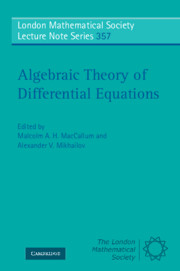Book contents
6 - Searching for integrable (P)DEs
Published online by Cambridge University Press: 03 May 2010
Summary
Abstract
Integrable dynamical systems are both rare and ubiquitous. It is therefore a worthy pursuit to find new integrable systems. In this contribution we give two examples of such search projects and discuss the computational algebraic problems this leads to.
Definitions of integrability
We will be discussing here the problem of searching for integrable systems. But at the very beginning it should be made clear that there is no unique definition of “integrability”. In broad terms we can say that an equation is integrable if its solutions behave nicely (cf. Painlevé property). However, this is not an operational definition, because we do not normally know all the solutions. Thus we have to look for certain properties of the equation, namely such properties that in some way imply “niceness” of its solutions.
One important observation that has been made about integrable systems is that there is always some interesting underlying mathematics. In a way this implies that among all equations the integrable ones are of measure zero, somewhat like prime numbers are among all numbers.
Since integrable dynamical system are rare it is of interest to search for and classify them. This is one of the important themes of research into integrable systems.
Different classes of dynamical systems have different properties that can be associated with integrability. In principle any property that guarantees regular behavior is of interest. The property can be directly associated with the equation:
for sets of ordinary differential equations: sufficient number of conserved quantities
for evolution equations: linearization through a Lax pair
for almost all systems: symmetries
2D-lattice partial difference equations: consistent extension to 3D.
Information
- Type
- Chapter
- Information
- Algebraic Theory of Differential Equations , pp. 217 - 231Publisher: Cambridge University PressPrint publication year: 2008
